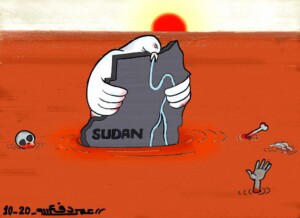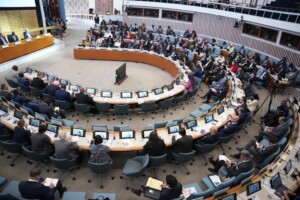OCHA Sudan bulletin 10: Over 102,000 people flee Jebel Marra
The UN Office for the Coordination of Humanitarian Affairs (OCHA) in Sudan reports in its latest weekly bulletin that people continue to flee their homes as a result of fighting between government forces and the Sudan Liberation Army led by Abdelwahid El Nur (SLM-AW) that started in Darfur’s Jebel Marra area in mid-January.
As of 6 March, over 102,700 people were reportedly displaced from Jebel Marra to various locations in North, Central and South Darfur, according to the UN and partners and the Government’s Humanitarian Aid Commission (HAC).
The UN Office for the Coordination of Humanitarian Affairs (OCHA) in Sudan reports in its latest weekly bulletin that people continue to flee their homes as a result of fighting between government forces and the Sudan Liberation Army led by Abdelwahid El Nur (SLM-AW) that started in Darfur’s Jebel Marra area in mid-January.
As of 6 March, over 102,700 people were reportedly displaced from Jebel Marra to various locations in North, Central and South Darfur, according to the UN and partners and the Government’s Humanitarian Aid Commission (HAC).
The total number people displaced from Jebel Marra in North Darfur has reached 98,013 as of 6 March, according to the International Organization for Migration (IOM) and partners. While the number of displaced people continues to increase in Tawila, Kabkabiya, and Shangil Tobaya, no new arrivals were reported in Sortony over the last two weeks.
According to HAC and aid organisations, an estimated 3,350 displaced from Jebel Marra have taken refuge in Central Darfur. This includes about 600 people in Zalingei’s Hamidiya and Hasahisa camps for the displaced and a further 2,750 displaced reported by HAC in Tur, Guldo and Niertiei.
However, UN agencies and partners are still unable to verify and assess the needs of newly arrived displaced in most places in Central Darfur. Despite being in Nierteti on 8 March, the Deputy Humanitarian Coordinator was denied access to the camps for the displaced there.
About 1,400 Jebel Marra displaced sought refuge in South Darfur. HAC in Kass reported the arrival of 555 IDPs in Kass IDP camp, of whom 415 have been registered so far.
On 28 February, the Sudanese Red Crescent Society (SRCS) completed a rapid needs assessment of 835 newly displaced people, among them 31 unaccompanied children, who have taken refuge near Deribat. More people are expected to arrive in the area soon.
According to HAC, the area of Deribat is dangerous given its close proximity to locations in Jebel Marra where military operations are reportedly ongoing.
Four million Sudanese at crisis levels of food insecurity or worse
According to the Famine Early Warning Systems Network (FEWS NET) Food Security Outlook Report for February 2016, the below-average agricultural production in 2015, expected high staple food prices, very poor pasture conditions, and continued conflict in Darfur, South Kordofan, and Blue Nile states are leading to greater food insecurity in 2016.
 The below-average cereal production is of particular concern in parts of North Kordofan, West Kordofan, Kassala, Red Sea, White Nile, and Darfur. Between March and September 2016, more than four million people will be in Crisis (IPC Phase 3) levels of food insecurity or worse.
The below-average cereal production is of particular concern in parts of North Kordofan, West Kordofan, Kassala, Red Sea, White Nile, and Darfur. Between March and September 2016, more than four million people will be in Crisis (IPC Phase 3) levels of food insecurity or worse.
Areas controlled by the Sudan People’s Liberation Movement-North (SPLM-N) in South Kordofan most probably reach Emergency (IPC Phase 4) levels of food insecurity, especially by the start of lean season in March 2016. In Darfur, displaced people affected by conflict in Jebel Marra will also most likely reach Emergency (IPC Phase 4) levels of food insecurity as well.
Moreover, pasture availability is estimated to be 40 to 60 percent below-average nationally, leading to large sales of livestock at below-average prices, which is expected to continue through June, according to FEWS NET. Very poor households in these areas are likely to exhaust their food stocks by the end of February and by March will experience Crisis (IPC Phase 3) levels of food insecurity.
South Sudanese refugees in Sudan down to 173,834, influx continues
As of 29 February, the registered number of South Sudanese who have arrived in Sudan since fighting erupted in South Sudan in mid-December 2013 was recorded as 173,834 following the completion of the roll-out of individual biometric registration in White Nile State.
On 22 February, local authorities in White Nile State finalised an agreement to establish a new site in Al Waral area (El Salam locality) which will diminish the overcrowding in existing sites in White Nile.
According to aid organisations on the ground and HAC, South Sudanese citizens have started arriving in East Darfur, South Darfur and West Kordofan states because of food shortages in their places of origin.
To date the number of people in East Darfur's Khor Omer camp has reached to 14,600 which is expected to increase as the influx continues with an average rate of 500 people (100 families) arriving daily since 16 February. In response to the needs of these new arrivals, the World Food Programme (WFP) has started food distributions and about 5,000 people (1,000 families) have received one-month rations so far.

In South Darfur, an estimated 1,600 South Sudanese (317 families) have reportedly arrived in the Belayil camp for the displaced and 25 people in El Radoom camp.
According to SRCS, security authorities have registered some 700 of new South Sudanese in West Kordofan. However, HAC estimates that the numbers could be higher because not all the refugees who have arrived in the last two weeks have been registered.
Read the full OCHA bulletin here











 and then
and then